Multilevel Modeling
Introduction and Recent Advances for Behavioral Research
Mark Lai
2018/12/04
Different Names
Hierarchical linear model (HLM; Raudenbush and Bryk, 2002)
Mixed/Mixed-effects model (Littell, Milliken, Stroup, and Wolfinger, 1996)
Random coefficient model (de Leeuw and Kreft, 1986)
Variance component model (Aitkin and Longford, 1986)
Roadmap
What are multilevel data?
Why use MLM?
- Avoid underestimated SE
- Cluster-specific (or person-specific) regression lines
- Avoid Ecological Fallacy
Recent advances
What Are Multilevel Data?
Multilevel Data
Nested Data
- Students in classrooms/schools
- Siblings in families
- Clients in therapy groups/therapists/clinics
- Employees in organizations in countries

Multilevel Data
- Repeated measures in individuals

Network Graph
Talk about level 1 and level 2
Applications of MLM
Psychotherapy
- Heterogeneity of treatment effectiveness across therapists
Educational research
- Teacher expectations on students' performance
Organizational research
- Job strain and ambulatory blood pressure
Applications of MLM (cont'd)
Cross-national/neighborhood research
- Sociopolitical influence on psychological processes (e.g., age and generalized trust)
- Post-materialism, locus of control, and concern for global warming
Longitudinal analysis/repeated measures
- Aging, self-esteem, and stress appraisal
Example Data
Sample simulated data on students' popularity
(Hox, Moerbeek, and Van de Schoot, 2018)
- 2000 pupils (level 1) in 100 classrooms (level 2)
Main outcome:
popular: popularity teacher evaluation (0 to 10)
Intraclass Correlation
ICC = ave r between 2 obs (students) in same cluster (class)
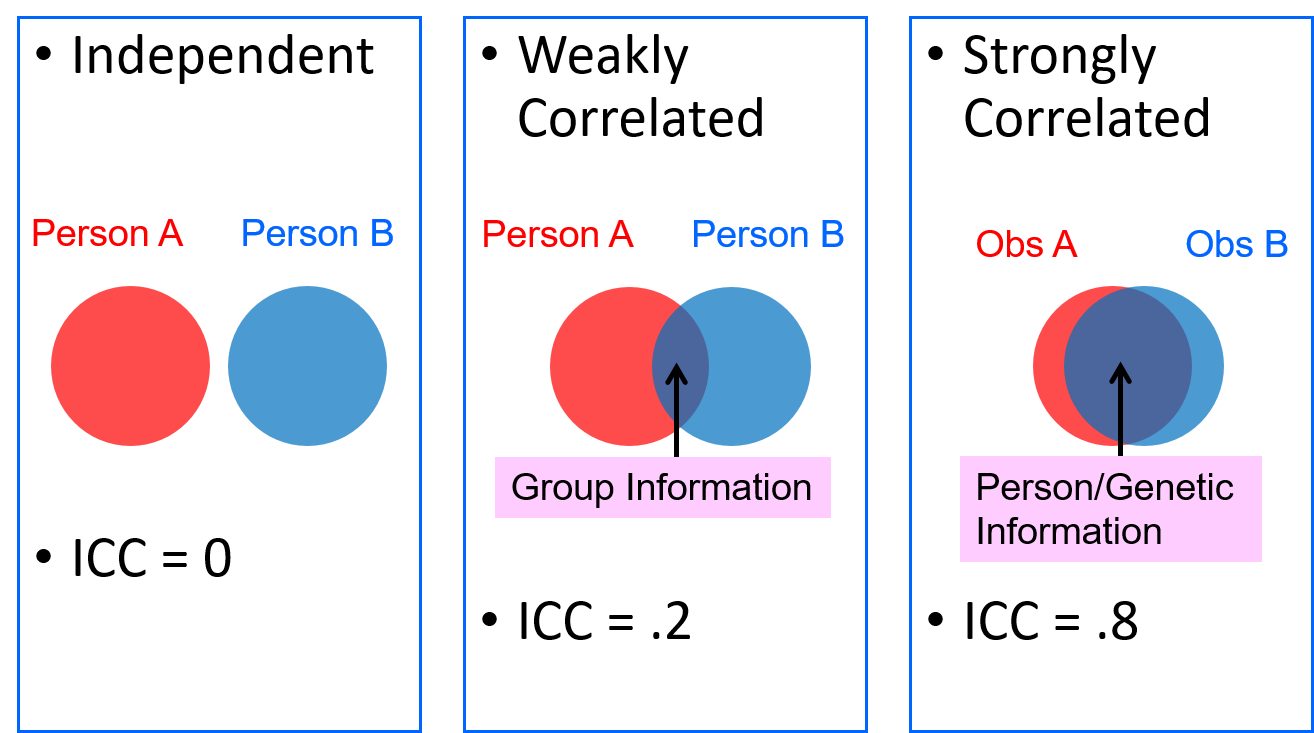
Why Use MLM?
- Avoid underestimated SE
- Cluster-specific (or person-specific) regression lines
- Avoid Ecological Fallacy
Dependent (Correlated) Observations
With clustered data, an assumption of OLS regression is violated
One score informs another score in the same cluster
Overlap: reduces effective information (\(N_\text{eff}\)) in data

Two students in the same class give less than two pieces of information
Consequences
Assuming independent obs, OLS understates the uncertainty in the estimates
- SE too small; CI too narrow
$${\uparrow}\, t = \frac{\hat\beta}{\mathit{SE}(\hat \beta)\, \downarrow}$$
Comparing OLS with MLM
| OLS | MLM | ||
|---|---|---|---|
| (Intercept) | 4.205 (0.071) | 4.197 (0.186) | |
| texp | 0.061 (0.005) | 0.062 (0.012) | |
| Num. obs. | 2000 | 2000 | |
| Num. groups: class | 100 | ||
OLS:
95% CI [0.052,
0.070].
MLM:
95% CI [0.038,
0.085].
Type I Error Inflation
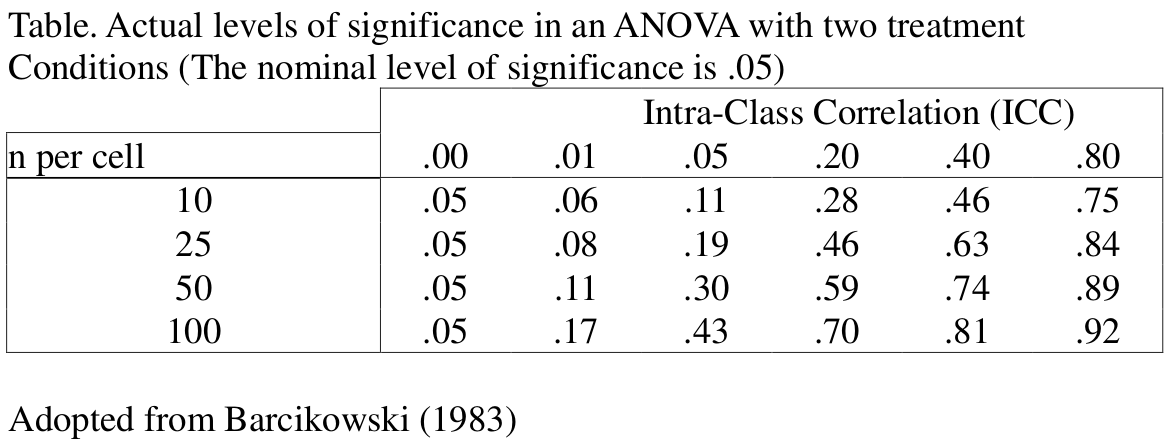
Depends on design effect: 1 + (cluster size - 1) × ICC
Lai and Kwok (2015): MLM needed when design effect > 1.1
For the popularity data, design effect
= 1 + (20 - 1) × .365 =
7.934
\(N_\text{eff}\) reduces by almost 8 times: 2000 → 252
Why Use MLM?
- Avoid underestimated SE
- Cluster-specific (or person-specific) regression lines
- Avoid Ecological Fallacy
Random Coefficient Model
Lv-1 predictor: not just problem on SE, OLS also ignore potential heterogeneity in regression lines
Consider extrav --> popular (with extrav mean centered)
OLS With All Data
Think About Just One Classroom
$$\texttt{popular}_i = \beta_0 + \beta_1 \texttt{extrav}_i + e_i$$
Think About Just One Classroom
$$\texttt{popular}_{i\color{red}{1}} = \beta_{0\color{red}{1}} + \beta_{1\color{red}{1}} \texttt{extrav}_{i\color{red}{1}} + e_{i\color{red}{1}}$$
Think About Classroom 35
$$\texttt{popular}_{i\color{blue}{35}} = \beta_{0\color{blue}{35}} + \beta_{1\color{blue}{35}} \texttt{extrav}_{i\color{blue}{35}} + e_{i\color{blue}{35}}$$
Classroom 14
$$\texttt{popular}_{i\color{green}{14}} = \beta_{0\color{green}{14}} + \beta_{1\color{green}{14}} \texttt{extrav}_{i\color{green}{14}} + e_{i\color{green}{14}}$$
MLM: efficiently get cluster-specific regression lines
$$\texttt{popular}_{i\color{purple}{j}} = \beta_{0\color{purple}{j}} + \beta_{1\color{purple}{j}} \texttt{extrav}_{i\color{purple}{j}} + e_{i\color{purple}{j}}$$
With heterogeneity in slopes, OLS gives underestimated SE (Lai and Kwok, 2015)
Detecting and explaining heterogeneity in slopes (i.e., cross-level interaction)
Growth Curve Analysis
Individual as "cluster"
Why Use MLM?
- Avoid underestimated SE
- Cluster-specific (or person-specific) regression lines
- Avoid Ecological Fallacy
Ecological Fallacy
Association between two variables can be different across levels
students' self-perception in academics
Ecological Fallacy
Association between two variables can be different across levels
Ecological Fallacy
Association between two variables can be different across levels
Big Fish Small Fond Effect
Ignoring clustering
Big Fish Small Fond Effect
+ve at student level
Big Fish Small Fond Effect
-ve contextual effect in a more competitive school
Why Use MLM?
- Avoid underestimated SE
- Cluster-specific (or person-specific) regression lines
- Avoid Ecological Fallacy
Recent Advances
Other Forms of Clustering
Three-level
Other Forms of Clustering
Cross-classification
Partial Nesting
Effect Size for Multilevel Trials
Effect size (e.g., Cohen's d) required by many reporting standards
- Little guidance on how to compute them
Effect Size for Multilevel Trials
Two-level trials: Hedges (2007)
Lai and Kwok (2014): (partially) cross-classified
Lai and Kwok (2016): partially nested
Rights and Sterba (2018): Defining \(R^2\) for MLM
Stice, Shaw, Burton, and Wade (2006)
Eating disorder prevention
Outcome: Thin-ideal internalization (TII)

Photo by daniellehelm / CC BY
| Dissonance-based (Treatment) | Expressive writing (Control) |
|---|---|
| \(N^T\) = 114 females | \(N^C\) = 126 females |
| 17 groups | |
| \(n\) = 6 to 10 | |
| ICC = .08, \(\mathit{deff}\) = 1.5 |
\(\hat \beta_\text{TREAT}\) = -0.44, SE = 0.09[1]
How many SDs does that correspond to?
[1] OLS underestimates SE by 25%; falsely assuming full clustering underestimates SE by 15%.
Lai and Kwok (2016)
$$\hat \delta = \frac{\hat \beta_\text{TREAT}}{\hat \sigma^2_\text{person}}$$
$$V(\hat \delta) = \frac{V(\hat \beta_\text{TREAT})}{\hat \sigma^2_\text{person}} + \frac{\hat \delta^2 V(\hat \sigma^2_\text{person})}{4 (\hat \sigma^2_\text{person})^2}$$
For Stice, Shaw, Burton, et al. (2006), \(\hat \delta\) = -0.98, 95% CI = [-1.4, -0.6]
Multilevel Bootstrapping
Useful for
- CI for effect size
- testing multilevel mediation
bootmlm R package (Lai, 2018):
currently implements 6 flavors of bootstrapping and 5 types of CI estimates
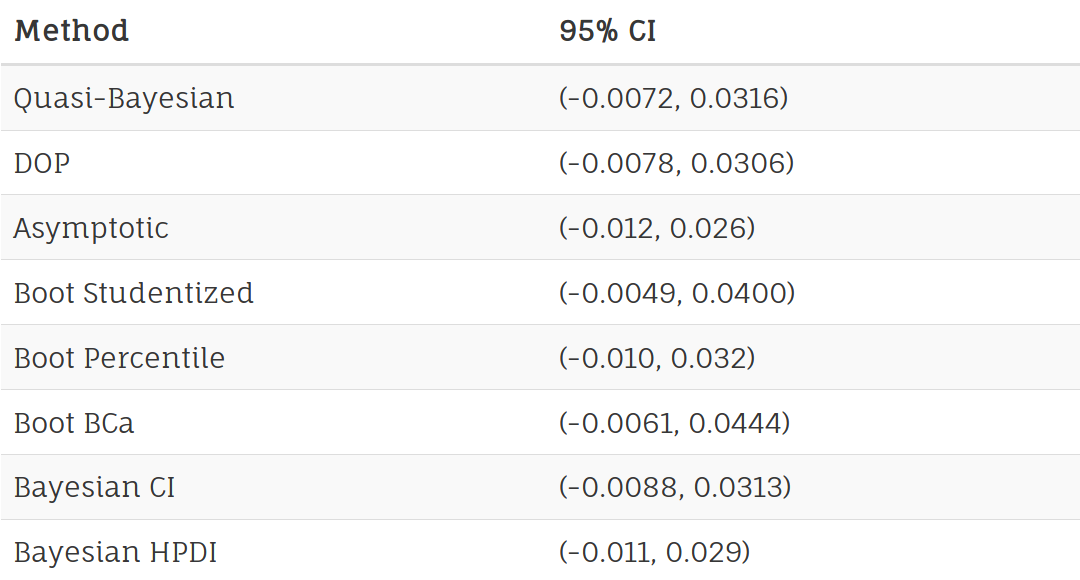
Accounting for Survey Design
Lai, Kwok, Hsiao, and Cao (2018)
- Apply finite population correction for cross-cultural research to obtain more accurate SE (and improved power)
Wen & Lai (in preparation)
- A multilevel Bayesian semi-parametric bootstrap procedure to handle sampling weights with unequal probability samples
(Lai, Kwok, Hsiao, et al., 2018, Figure 5)
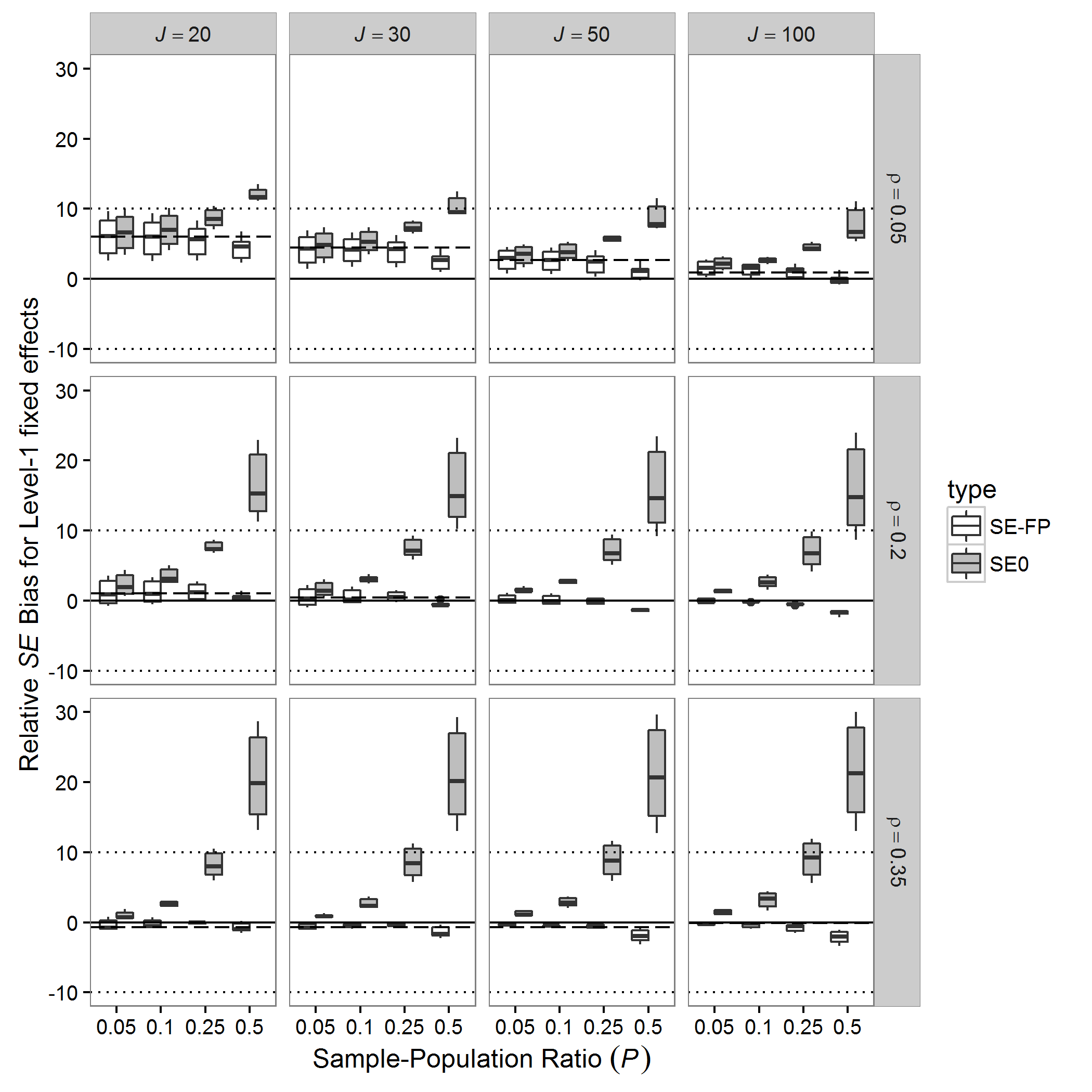
MLM of Non-Normal Outcomes
Ordinal? Counts? Zero-inflated? Proportions? Response time? Survival?
These are made easy with Bayesian estimation and the brms package
(Bürkner, 2018).
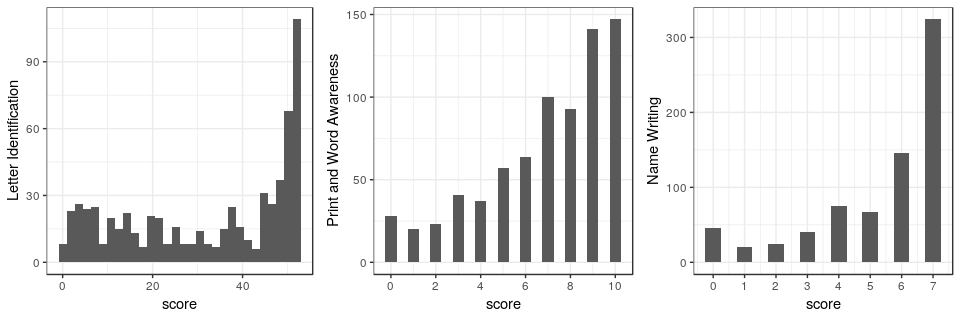
Final Remarks
Reasons for MLM: correct SE, model heterogeneity, avoid ecological fallacy
Methodological research: translate methods in single-level research + methods for new RQ
More truly multilevel theories
Bibliography
Aitkin, M. and N. Longford (1986). "Statistical modelling issues in school effectiveness studies". In: Journal of the Royal Statistical Society. Series A (General) 149, pp. 1-43. DOI: 10.2307/2981882.
Bürkner, P. (2018). "Advanced Bayesian Multilevel Modeling with the R Package brms". In: The R Journal 10.1, pp. 395-411.
Hedges, L. V. (2007). "Effect sizes in cluster-randomized designs". In: Journal of Educational and Behavioral Statistics 32, pp. 341-370. DOI: 10.3102/1076998606298043.
Hox, J. J, M. Moerbeek and R. Van de Schoot (2018). Multilevel analysis: Techniques and applications. 3rd ed. New York, NY: Routledge.
Lai, M. H. C. (2018). marklhc/bootmlm: bootmlm: bootstrap resampling for multilevel models. DOI: 10.5281/zenodo.1879127.
Lai, M. H. C. and O. Kwok (2014). "Standardized mean differences in two-level cross-classified random effects models". In: Journal of Educational and Behavioral Statistics 39.4, pp. 282-302. DOI: 10.3102/1076998614532950.
Lai, M. H. C. and O. Kwok (2015). "Examining the rule of thumb of not using multilevel modeling: The “design effect smaller than two” rule". En. In: The Journal of Experimental Education 83.3, pp. 423-438. DOI: 10.1080/00220973.2014.907229.
Lai, M. H. C. and O. Kwok (2016). "Estimating standardized effect sizes for two- and three-level partially nested data". In: Multivariate Behavioral Research, pp. 1-17. DOI: 10.1080/00273171.2016.1231606.
Lai, M. H. C, O. Kwok, Y. Hsiao, et al. (2018). "Finite population correction for two-level hierarchical linear models.". In: Psychological Methods 23.1, pp. 94-112. DOI: 10.1037/met0000137.
Leeuw, J. de and I. Kreft (1986). "Random coefficient models for multilevel analysis". In: Journal of Educational Statistics 11, pp. 57-85. DOI: 10.2307/1164848.
Littell, R. C, G. A. Milliken, W. W. Stroup, et al. (1996). SAS System for mixed models. Cary, NC: SAS.
Raudenbush, S. W. and A. S. Bryk (2002). Hierarchical linear models: Applications and data analysis methods. 2nd ed. Thousand Oaks, CA: Sage.
Rights, J. D. and S. K. Sterba (2018). "Quantifying explained variance in multilevel models: An integrative framework for defining R-squared measures.". In: Psychological Methods. ISSN: 1939-1463. DOI: 10.1037/met0000184.
Stice, E, H. Shaw, E. Burton, et al. (2006). "Dissonance and healthy weight eating disorder prevention programs: A randomized efficacy trial.". In: Journal of Consulting and Clinical Psychology 74, pp. 263-275. DOI: 10.1037/0022-006X.74.2.263.
Fixed Effect Estimates
| (intercept) | 5.031 (0.097) | |
| extravc | 0.493 (0.025) | |
| Var(intercept) | 0.892 | |
| Var(slope) | 0.026 | |
| Cov(int, slope) | -0.134 | |
| Var(residual) | 0.895 | |
Average slope of extrav = 0.493, 95% CI
[0.442, 0.543].
Random Effect Variance Estimates
| (intercept) | 5.031 (0.097) | |
| extravc | 0.493 (0.025) | |
| Var(intercept) | 0.892 | |
| Var(slope) | 0.026 | |
| Cov(int, slope) | -0.134 | |
| Var(residual) | 0.895 | |
Variance of slopes = 0.026 (SD = 0.161)
- For a majority of schools (within +/- 1 SD), slope expected in the range [0.332, 0.654].
for linear relations, only need to know the intercept and the slope;